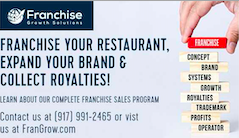Image created with canva
Franchise Growth Solutions and ADP are hosting the New York Franchisor Forum on November 1, 2024, at ADP’s NYC office. This event is for franchisors and those interested in franchising, offering key strategies and expert advice to grow their franchise brands. Registration is open until October 25, but space is limited, so reserve your spot now!
FRANCHISE GROWTH SOLUTIONS & ADP TO HOST EXCLUSIVE NEW YORK FRANCHISOR FORUM – NOVEMBER 1, 2024
Franchise Growth Solutions is excited to announce the New York Franchisor Forum, an exclusive one-day event for franchisors and anyone considering franchising their business, on Friday, November 1, 2024, at ADP’s NYC office. This highly anticipated Event is designed to equip franchisors with the essential strategies, insights, and connections needed to expand and scale their franchise brands effectively.
Event Details:
Date: Friday, November 1, 2024
Time: 9:00 AM – 4:00 PM
Location: ADP NYC Office
One Penn Plaza, 23rd Floor
New York, NY
CHECK THE AGENDA BELOW

Meet the Speakers & Panelists:
The New York Franchisor Forum will feature some of the most accomplished leaders in the franchising and business sectors. Here’s a closer look at the panelists who will be sharing their expertise:
Gary Occhiogrosso

Gary Occhiogrosso is the Founder of Franchise Growth Solutions, a co-operative based franchise development and sales firm. His proprietary “Coach, Mentor & Grow Program” focuses on helping Franchisors with their franchise development, strategic planning, advertising, selling franchises and guiding franchisors in raising growth capital.
Gary started his career in franchising as a franchisee of Dunkin Donuts before launching the Ranch *1 Franchise program. He is the former President of TRUFOODS, LLC a 100+ unit multi brand franchisor and former COO of Desert Moon Fresh Mexican Grille.
Gary was selected as “Top 25 Fast Casual Restaurant Executive in the USA” by Fast Casual Magazine as well as begin named Top 100 Franchise Influencers in 2021, 2022, & 2023 by SEO Samba and 1851 Magazine.
In addition, Gary was an adjunct associate professor at New York University on the topics of Restaurant Concept Development, Entrepreneurship and Franchising. He has published numerous articles on the topics of Franchising, Entrepreneurship, Sales and Marketing. He is also the author of the E-Guide: Is Your Business “Franchiseable”?
He was the host of the NYC’s “Small Business & Franchise Radio Show” and currently the host of the podcast “MasterMind Minutes.” Gary is also the publisher of the online magazine FranchiseMoneyMaker.com as well as a contributing writer for Forbes.com
OPTIMIZING LEAD GENERATION
Rafael Viaud

Rafael Viaud, VP of Business Development at Executel, is a charismatic leader with over 15 years of experience in driving business growth through strategic networking and lead generation. His expertise in market expansion and operational excellence has led to significant sales achievements across the Finance, Technology, and BPO sectors. He brings a wealth of knowledge in client acquisition, team building, and data-driven decision-making.
Sean McKay

Sean McKay is a seasoned expert in web design and digital marketing, currently leading business development at Site Hub. With over a decade of experience, Sean has successfully cultivated a strong client base in Government, B2B, and niche sectors, specializing in branding, web design, and advertising.
Matt Jonas

As the President and Co-Founder of TopFire Media, Matt Jonas has more than two decades of experience in digital media and franchise marketing. Under his leadership, TopFire Media has become one of North America’s premier marketing agencies, focusing on lead generation and strategic branding. Matt’s insights will bring valuable marketing strategies to the forum.
===========================
MANAGING ROGUE FRANCHISEE AND ENFORCING FRANCHISE COMPLIANCE
Harold Kestenbaum

With over four decades of experience, Harold Kestenbaum is a franchise law expert who has served as general counsel to major franchisors, including Sbarro, Inc. His deep knowledge of franchise law, combined with his practical experience as a franchisor, makes him a leading authority on franchise compliance and management.
Lisa Oak

A franchise development and business growth strategist, Lisa Oak has held leadership roles within the SUBWAY® organization and has advised emerging brands. With expertise in executive coaching, negotiations, and strategic planning, Lisa has helped shape the growth of several franchise companies.
Paul Gucciardo

As Brand President at Sobol, Paul Gucciardo is a skilled negotiator with extensive experience in franchise system development, team building, and account management. His expertise will offer attendees practical advice on managing operations within franchise networks.
Victor Turcanu

Victor Turcanu is an attorney with Spadea Law specializing in franchise law. His legal expertise ensures that franchise operations remain compliant and protected from legal challenges.
=========================
PRIVATE EQUITY IN FRANCHISING
Alicia Miller

Alicia Miller is the Founder and Managing Director of Emergent Growth Advisors, a strategic advisory firm that focuses on franchising and private equity. She advises franchise management teams on growth challenges and helps private equity firms with strategy and value creation. As a former multi-unit franchisee, Alicia brings a unique operator’s perspective and has written over 80 articles on franchising. She is also an advisor for the International Franchise Association’s CFE program.
Michael Ledecky

Michael Ledecky is the Founder and Managing Partner of Clay Path Partners, an entrepreneur-led search fund that helps business owners transition their companies while preserving the founder’s legacy. His private equity insights will shed light on the critical role of investment in franchise growth.
Robert Tobias

Robert Tobias, founder of Elite Franchise Capital, has spent two decades specializing in strategic investments within emerging franchise brands. His extensive experience in franchise management and expansion will provide attendees with actionable strategies for growth.
Sean Whitehead

Sean Whitehead, an investor with NewSpring Capital, brings expertise in private equity, with a focus on fostering franchise growth through strategic investments. His insights will guide franchisors on how to attract and leverage private equity.
Scott Romanoff

Scott Romanoff brings nearly three decades of experience from Goldman Sachs, where he served as a Partner for 12 years. During his tenure, he worked in both New York and London within the Investment Banking Division and the Executive Office. Scott led Corporate Development and co-headed the Financial Institutions Financing Group, advising on debt and equity financing as well as risk management. He also held key leadership roles, including Co-Chair of the Significant Acquisitions Oversight Group and served on the GS Bank Management and Firm-wide Finance Committees.
=======================
Strategies and Tactics for Effective Franchise Sales
Daniel Claps

Daniel Claps, CEO of Voda Cleaning & Restoration, is a serial entrepreneur with a background in franchise lead generation and business development. Known for his innovative approach, Daniel has co-founded several successful ventures in the franchise sector.
Ben Woodruff

Ben Woodruff, CEO of Whoops, is a seasoned franchise leader with over 20 years of experience. His focus on performance metrics and strategic planning has made him a successful operator and leader within the franchise industry.
Aimee Kirvan

Aimee Kirvan is the co-founder of Kirvan Consulting, a franchise development and sales organization. With over 20 years of experience in the restaurant and service sectors, Aimee specializes in franchise sales for start-up and emerging brands.
Free Registatration:
https://events.adp.com/profile/form/index.cfm?PKformID=0x80694abcd&source=FranchiseGrowthSolutions
For more information contact Camila Mojica at [email protected] (201) 534-5610


























